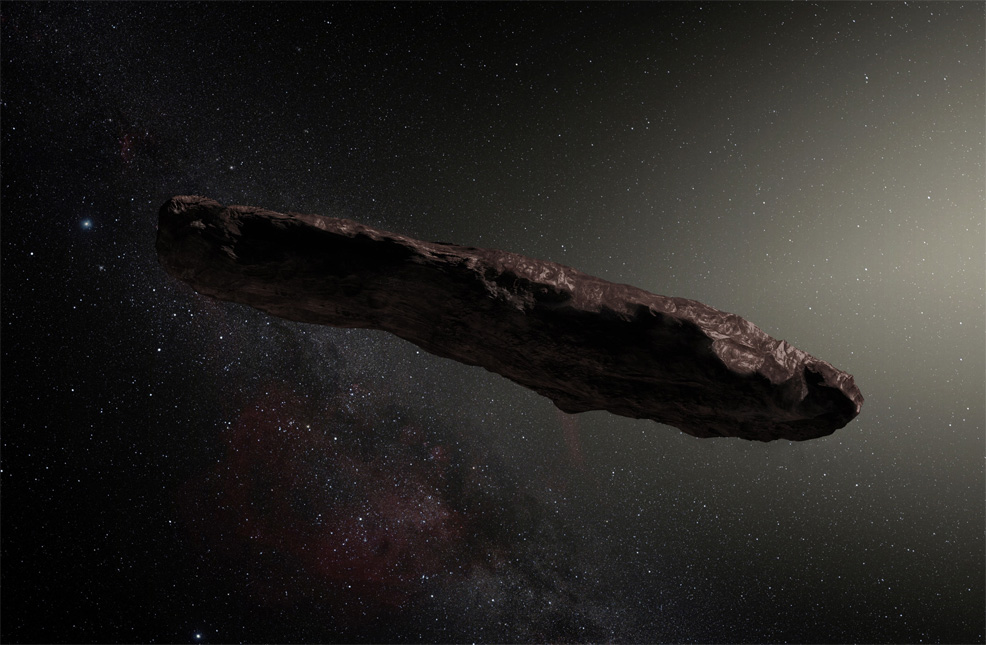
2054
Mission to interstellar object ‘Oumuamua
Discovered in 2017, ‘Oumuamua became the first known interstellar object to be detected passing through the Solar System. Studies of the trajectory placed it some 33 million km (21 million mi; 0.22 AU) from Earth, and already heading away from the Sun. Astronomers noted its unusual shape – like that of a cigar – measuring somewhere between 100 and 1,000 metres in length. It had a red colour and lacked any sort of coma.
Its high speed, relative to the Sun, proved to be key in determining an extrasolar origin, although the exact planetary system it had travelled from, and the duration of its long excursion remained unknown. Future extrapolations of ‘Oumuamua’s path showed it would never be captured into a solar orbit, so would eventually leave the Solar System and continue into interstellar space.

Original: ESO/M. Kornmesser Derivative: nagualdesign, CC BY-SA 4.0, via Wikimedia Commons
A small number of astronomers suggested that ‘Oumuamua could be a product of alien technology, based on six anomalous properties that made it unusual and unlike any comets or asteroids seen before. However, the scientific evidence in support of this hypothesis proved to be weak. In 2019, astronomers discovered a second interstellar object, called 2I/Borisov.*
The Initiative for Interstellar Studies (i4is) revealed Project Lyra,* a set of mission concepts for reaching ‘Oumuamua, as well as 2I/Borisov, and other yet to be discovered interstellar objects. Early proposed methods involved using near-term technologies for a solar Oberth manoeuvre (SOM), taking a probe close to the Sun and relying on its radiation pressure to obtain a very high velocity, with a light sail.
However, an alternative proposal later emerged for a “Jupiter Oberth manoeuvre” (JOM), which calculations showed would be even more efficient at generating the high speeds needed to catch up with such a distant object. Using the gas giant for a reverse gravitational assist would also reduce the spacecraft’s mass, as a heat shield would not be necessary. Researchers found that a JOM could shave more than 10 AU off the journey length, while also providing more time to observe the object during a probe’s closest approach. It would fly past at 18 km/s (64,800 km/h; 40,265 mph), rather than 30 km/s (108,000 km/h; 67,108 mph) for a spacecraft relying on a SOM.*
These advantages – and the rare opportunity to explore such a unique object – gave Project Lyra credibility with space agencies and private interests, enabling it to attract funding and progress onto the next research and development phases. After passing through the selection process, mission planners took advantage of a launch window in 2028.
The probe swings by Venus (2028), before heading back to Earth (2029), performing a deep space manoeuvre at 2.2 AU in 2030, returning to Earth (2031) and then heading to Jupiter (2032), where it accelerates towards ‘Oumuamua. After a total journey time of 26 years, it arrives in 2054,* having covered a distance of more than 200 AU, or about quadruple the aphelion of Pluto. This mission provides the first ever close-range study of material from beyond the Solar System, generating major scientific returns. It also helps to resolve the earlier questions that arose, such as its system of origin. By now, a few other long-range missions are underway as humanity continues to extend its reach and capabilities in space.
Rainfall intensity has increased by 20%
As the world warms, the increased evaporation is putting greater amounts of water vapour into the atmosphere. Rainfall intensity rises by 7% for each degree of additional warming.* With temperatures approaching 3°C (5.4°F) above the 20th century average, the most extreme rainfall events are now 20% more intense than before. Dramatic increases in surface runoff, peak river flows and flash flooding are being experienced around the world – exacerbating soil erosion and putting huge pressure on drainage and sewage systems. This additional rainfall is a particular problem in the tropics and poor regions with insufficient infrastructure or flood defences.
